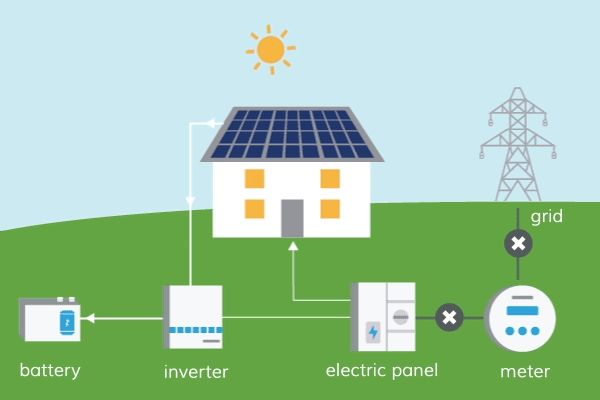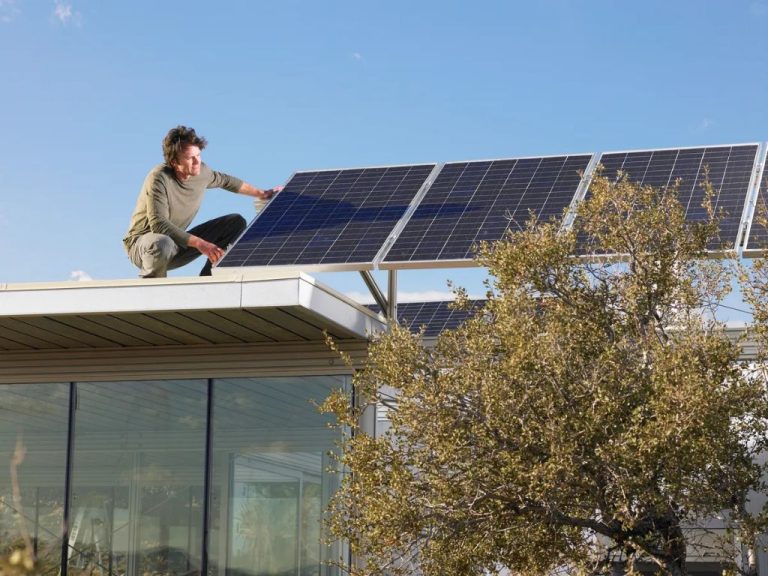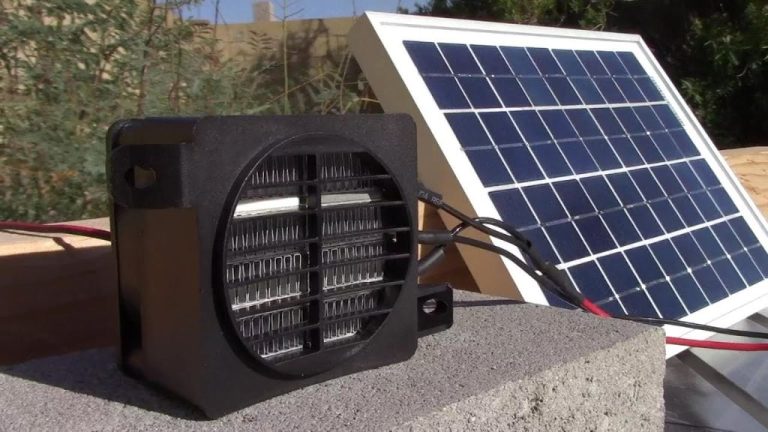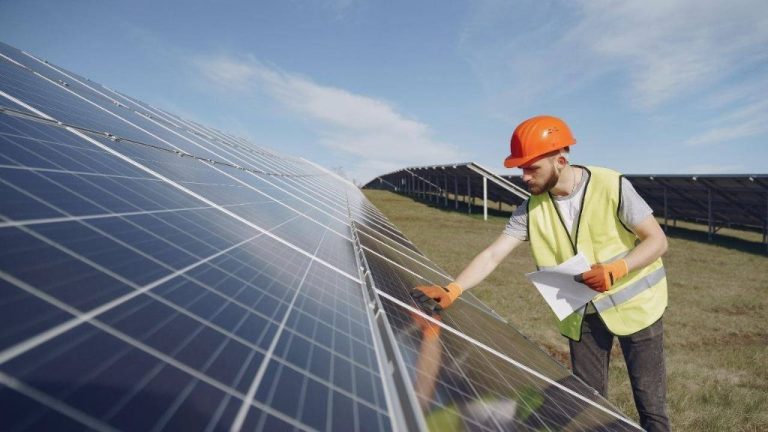How Is Solar Energy Stored For Later Use?

Solar energy refers to the energy generated by capturing heat and light from the sun. Solar panels convert sunlight into electricity that can be used right away or sent into the electricity grid. However, solar energy has limitations since the sun is not always shining. Therefore, it is important to be able to store solar energy for use when the sun is not available.
Storing solar energy allows for its wider use and overcomes the intermittent nature of solar generation. By storing excess solar energy when available, it can be used at night or on cloudy days. Stored solar energy also provides a clean energy source and reduces reliance on fossil fuels. It enables energy independence and cost savings for consumers. Overall, effective storage is key to unlocking the full potential of solar power.
Batteries
Batteries are one of the most common ways to store solar energy for later use. They store energy chemically for use whenever needed, which allows solar energy to be used around the clock, not just when the sun is shining. The most popular batteries used for solar energy storage are lead acid, lithium-ion, and flow batteries.
Lead acid batteries are the traditional rechargeable battery used in many applications. They are reliable and inexpensive but have a shorter lifespan than other battery types (Solar Energy Storage). Lithium-ion batteries have become popular for solar storage thanks to their high energy density, low maintenance, long life, and decreasing costs. Flow batteries like vanadium redox are large capacity batteries well-suited for large-scale energy storage (How To Store Solar Energy In Batteries).
The main benefits of using batteries to store solar power are that they allow self-consumption of solar energy, provide backup power during grid outages, and reduce electricity costs by storing excess solar energy during the day for use at night. Batteries also enable solar power to be used 24/7. The downsides are that batteries can be expensive upfront, gradually lose storage capacity over time, and require proper maintenance and replacement (Home – Wintersun). Overall, batteries provide a flexible and scalable way to store solar energy for residential and commercial uses.
Pumped Hydro Storage
Pumped hydro storage works by using excess electricity to pump water from a lower reservoir to an upper reservoir. When electricity demand is high, the water can be released from the upper reservoir back down to the lower reservoir to turn turbines and generate electricity (Source).
Some locations that utilize pumped hydro storage include the Pacific Northwest, California, and the Rocky Mountains where there are reservoirs at different elevations that can be leveraged (Source).
Pros of pumped hydro storage include its ability to store large capacities of energy, quick response times to meet electricity demands, and long lifespan with low maintenance costs. Cons include its geographical constraints requiring specific terrain and impact on ecosystems and water flows (Source).
Compressed Air Energy Storage
Compressed air energy storage (CAES) is an approach that uses off-peak electricity to compress and store air in an underground reservoir. When electricity demand is high, the compressed air is released and heated with natural gas or biogas to drive a turbine and generate electricity source.
CAES is well-suited for use with renewable energy sources like wind and solar that may have variable output. The compressed air acts as a type of battery that can store energy for later use. CAES plants are in operation in Germany and the United States. One key advantage is the storage of large amounts of energy to help balance electricity supply and demand source.
However, CAES requires specific geological formations like salt caverns or aquifers to store the compressed air. The compression also consumes a lot of electricity. Adding natural gas combustion to reheat the air upon expansion reduces the overall efficiency and renewable energy integration compared to pure compressed air. There are efforts to develop CAES plants that use thermal energy storage instead of fossil fuels.
Flywheel Energy Storage
Flywheel energy storage works by accelerating a rotor (flywheel) to a very high speed and maintaining the energy in the system as rotational energy. When energy is needed, the flywheel’s rotational speed is reduced to produce electricity via a generator. Flywheels typically reach rotational speeds of 20,000 to over 50,000 rpm in a sealed enclosure with minimal friction losses.
Flywheel installations can respond quickly to changes in energy demand, making them well-suited for frequency regulation of the grid. They have been used to provide grid stabilization services and Uninterruptible Power Supply (UPS) applications. Some locations using flywheel storage include the 20 MW system installed at the Oahu wind farm in Hawaii and a 5 MW system installed at the Rosières-aux-Salines facility in France.
The main advantages of flywheel energy storage are high cycle life, low maintenance, and long service lifetime of around 20 years. Drawbacks are high self-discharge rates and low energy density. Flywheels also have high round-trip efficiency up to around 85-90%. Overall, flywheels excel at high power quality, frequency regulation, and bridging power gaps up to around 15 minutes.
Sources:
https://www.mdpi.com/1996-1073/12/17/3356
https://www.pinterest.com/pin/414401603193909221/
Thermal Energy Storage
Thermal energy storage allows solar thermal energy to be stored for later use when the sun is not shining. Some common methods for thermal energy storage include:
Phase change materials (PCMs) store heat by melting and solidifying at certain temperatures. PCMs like salt hydrates and paraffin waxes can absorb excess heat during the day as they melt. The heat is then released at night as they resolidify. PCMs are low cost but have lower energy storage densities than other methods [1].
Molten salts can also be used to store significant amounts of thermal energy. Salt mixtures like sodium and potassium nitrate are stored in insulated tanks. During the day as heat is collected, the salts are heated to high temperatures where they melt. The molten salts can then be used to generate steam and electricity on demand when solar energy is unavailable [2].
Overall, thermal energy storage provides a low-cost way to store the sun’s heat for later use in solar thermal power plants, heating systems, and industrial processes [3].
Hydrogen is an efficient and flexible energy carrier that can be produced from renewable energy sources like solar, stored, and then used to generate electricity on demand. One key advantage of using renewable hydrogen for energy storage is that it can address the intermittency of solar power generation. When solar panels produce excess electricity, that energy can be used to produce hydrogen through electrolysis. The hydrogen can then be stored and used later to generate electricity in a fuel cell when solar production is lower.
Hydrogen Storage
Hydrogen has a very high energy density by weight, but its low density as a gas makes volumetric storage challenging. Current hydrogen storage methods include compression, liquefaction, physical storage in solids via adsorption, and chemical storage in materials that absorb and release hydrogen through reversible reactions. Research is ongoing to develop optimal materials and systems for hydrogen storage, including metal hydrides, carbon nanotubes, and synthetic chemical hydrogen carriers. While still in early stages, power-to-gas systems show promise for converting excess renewable energy to hydrogen, injecting it into natural gas pipelines for storage and distribution, then extracting it to generate electricity in fuel cells. Several pilot projects are testing solar-to-hydrogen systems at scales up to the multi-megawatt range.1
Other Methods
There are a few other emerging methods for storing solar energy besides the main ones discussed. These include:
Molten salt storage – This involves heating a molten salt mixture that can retain heat for long periods of time. The hot molten salt can then be used to produce steam to generate electricity on demand.https://www.ncbi.nlm.nih.gov/pmc/articles/PMC9426646/
Thermochemical storage – This uses chemical reactions that absorb and release heat for storage. For example, metal oxides can be reversibly reduced and oxidized in reaction cycles to store and release solar heat.https://www.ncbi.nlm.nih.gov/pmc/articles/PMC9426646/
Photochemical storage – This converts solar energy into chemical bonds, storing the energy in chemical fuels that can be used when needed. Methods like artificial photosynthesis are being researched.
While promising, these other methods are still in early research and development stages. The commercial viability and large-scale implementation potential of these emerging solar energy storage technologies remains to be seen.
Comparisons
When evaluating different solar energy storage methods, some key factors to consider are efficiency, cost, limitations, and more.
In terms of efficiency, lithium-ion batteries tend to score highest among battery technologies with around 90-95% roundtrip efficiency. Lead-acid batteries are lower at around 75-80% efficiency. For thermal storage, efficiency can reach up to 90% as well. Pumped hydro and compressed air energy storage have somewhat lower roundtrip efficiencies in the 60-70% range. Flywheel energy storage tops out around 85% roundtrip efficiency.
Looking at costs, lead-acid batteries have historically been the most affordable option, though prices are declining for lithium-ion batteries too. Thermal energy storage tends to be one of the most cost-effective methods. Pumped hydro requires suitable terrain and can have very high upfront capital costs, though low operating costs. Compressed air energy storage also involves substantial infrastructure and terrain requirements.
In terms of limitations, most battery technologies like lithium-ion and lead-acid offer short-duration storage of up to 10 hours. Pumped hydro storage and compressed air energy storage allow longer-duration storage. Batteries take up relatively little space but pumped hydro and compressed air require large underground caverns or reservoirs. Thermal storage takes advantage of existing hot water infrastructure but depends on insulation quality.
Overall, no single energy storage method is ideal across the board. The optimal solution depends on the specific needs and constraints of each solar power system and application.
Conclusion
As discussed, there are several promising methods for storing solar energy for later use. The main methods include batteries, pumped hydro storage, compressed air energy storage, flywheel energy storage, thermal energy storage, and hydrogen storage. Each method has its own advantages and disadvantages in terms of efficiency, storage capacity, duration, cost, location constraints, and more. Key comparisons were provided between the different technologies.
Energy storage is critical for enabling the continued growth of solar power and other renewable energy sources. Since the sun is not always shining and demand fluctuates, storing excess solar energy when it’s abundant allows it to be used later when needed. Widespread energy storage will help overcome the intermittency issues of renewables and make them more viable and reliable energy sources.
Further development and deployment of energy storage technologies will be vital for building a more sustainable energy future based on high levels of solar power and other renewables. Both large-scale grid energy storage and small-scale behind-the-meter storage have key roles to play in this transition.







